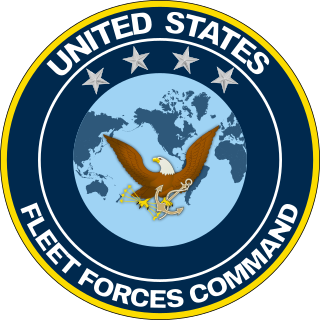
The United States Fleet Forces Command (USFF) is a service component command of the United States Navy that provides naval forces to a wide variety of U.S. forces. The naval resources may be allocated to Combatant Commanders such as United States Northern Command (USNORTHCOM) under the authority of the Secretary of Defense. Originally formed as United States Atlantic Fleet (USLANTFLT) in 1906, it has been an integral part of the defense of the United States of America since the early 20th century. In 2002, the Fleet comprised over 118,000 Navy and Marine Corps personnel serving on 186 ships and in 1,300 aircraft, with an area of responsibility ranging over most of the Atlantic Ocean from the North Pole to the South Pole, the Caribbean Sea, Gulf of Mexico, and the waters of the Pacific Ocean along the coasts of Central and South America.

VP-23, Patrol Squadron 23, known as the Seahawks, was a U.S. Navy fixed-wing, anti-submarine and maritime patrol squadron based at Brunswick Naval Air Station, Brunswick, Maine, United States. It was established as Weather Reconnaissance Squadron Three (VPW-3) on 17 May 1946, redesignated as Meteorology Squadron Three (VPM-3) on 15 November 1946, redesignated Heavy Patrol Squadron (Landplane) Three (VP-HL-3) on 8 December 1947, and to Patrol Squadron Twenty Three (VP-23) on 1 September 1948 and disestablished on 28 February 1995. It was the second squadron to be designated VP-23, the first VP-23 was redesignated Patrol Bombing Squadron 23 (VPB-23) on 1 October 1944 and disestablished on 25 January 1946.
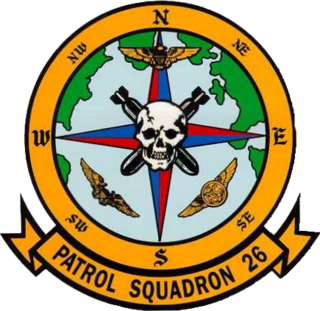
The VP-26 Tridents are a United States Navy aircraft squadron based at Naval Air Station Jacksonville in Florida. The squadron flies Boeing P-8A patrol aircraft. It was established as Bombing Squadron 114 (VB-114) on 26 August 1943 and renamed Patrol Bombing Squadron 114 (VPB-114) on 1 October 1944; Patrol Squadron 114 (VP-114) on 15 May 1946; Heavy Patrol Squadron (Landplane) 6 (VP-HL-6) on 15 November 1946, and Patrol Squadron 26 (VP-26) on 1 September 1948. The Tridents are the third squadron to be designated VP-26; the first VP-26 was renamed VP-102 on 16 December 1940, and the second VP-26 was renamed VP-14 on 1 July 1941.

736 Naval Air Squadron was a Naval Air Squadron of the Royal Navy's Fleet Air Arm. It was most recently recommissioned at HMS Seahawk, RNAS Culdrose in June 2013 to fly the BAE Systems Hawk, mainly in the maritime aggressor role, following the disbandment of the Fleet Requirements and Aircraft Direction Unit (FRADU) and operated up until March 2022. It initially formed as the School of Air Combat in May 1943 at HMS Heron, RNAS Yeovilton. In September 1943 it moved to HMS Vulture, RNAS St Merryn, where it became the Fighter Combat School and it created an independent 'B' Flight for fighter affiliation work between March and September 1945. 736 Naval Air Squadron moved to HMS Seahawk, RNAS Culdrose in February 1950 as the Naval Air Fighter School in the 52nd Training Air Group, but disbanded in August 1952. Immediately the following day, the squadron reformed at HMS Seahawk, RNAS Culdrose out of 702 Naval Air Squadron as an Advanced Jet Flying School and in November 1953 it moved to HMS Fulmar, RNAS Lossiemouth. 736 Naval Air Squadron disbanded there in March 1965, but what was left became 764 Naval Air Squadron ‘B’ Flight. The squadron reformed the same day at Lossiemouth from 809 Naval Air Squadron as a Jet Strike Training Squadron. 1966. In March 1967, its aircraft were part of the group that bombed and set on fire the supertanker SS Torrey Canyon aground and leaking crude oil on Seven Sisters rocks off Cornwall. The squadron disbanded in February 1972.

Patrol Squadron 46 (VP-46), also known as the "Grey Knights", is a maritime patrol squadron of the United States Navy based at Naval Air Station Whidbey Island, Washington. Part of Patrol and Reconnaissance Wing Ten, VP-46 is the oldest maritime patrol squadron and the second oldest aircraft squadron in the entire U.S. Navy, second only behind VFA-14.
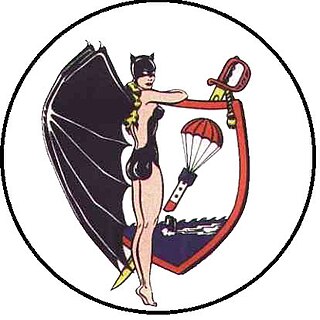
Patrol Squadron 24 (VP-24) was a Patrol Squadron of the U.S. Navy. The squadron was established as Bombing Squadron One Hundred Four (VB-104) on 10 April 1943, redesignated as Patrol Bombing Squadron One Hundred Four (VPB-104) on 1 October 1944, redesignated as Patrol Squadron One Hundred Four (VP-104) on 15 May 1946, redesignated Heavy Patrol Squadron (Landplane) Four (VP-HL-4) on 15 November 1946, redesignated Patrol Squadron Twenty Four (VP-24) on 1 September 1948, the third squadron to be assigned the VP-24 designation, redesignated Attack Mining Squadron Thirteen (VA-HM-13) on 1 July 1956, redesignated Patrol Squadron Twenty Four (VP-24) on 1 July 1959 and disestablished 30 April 1995.

Patrol Squadron 47 (VP-47), also known as "The Golden Swordsmen", is a maritime patrol squadron of the United States Navy based at Naval Air Station Whidbey Island, Washington (USA), attached to Patrol and Reconnaissance Wing 10. The squadron currently flies the Boeing P-8A Poseidon.

Patrol Squadron Four (VP-4) is a U.S. Navy land-based patrol squadron based at the Naval Air Station Whidbey Island, Oak Harbor, Washington, which is tasked to undertake maritime patrol, anti-submarine warfare (ASW), and intelligence, surveillance and reconnaissance (ISR) missions flying the Boeing P-8 Poseidon.
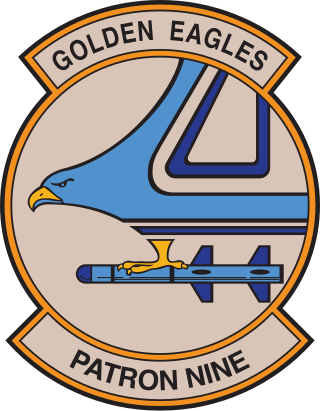
Patrol Squadron 9 (VP-9) is a U.S. Navy patrol squadron with its homeport located at Naval Air Station Whidbey Island. As of 2018, VP-9 is part of Patrol and Reconnaissance Wing Ten, Commander, Naval Air Forces, Pacific.

VP-17, nicknamed the White Lightnings, was a Patrol Squadron of the U.S. Navy.

VP-6 was a long-lived Patrol Squadron of the U.S. Navy, nicknamed the Blue Sharks. Originally established as Bombing Squadron VB-146 on 15 July 1943, it was redesignated Patrol Bombing Squadron VPB-146 on 1 October 1944, redesignated VP-146 on 15 May 1946, redesignated Medium Patrol Squadron (Landplane) VP-ML-6 on 15 November 1946, redesignated VP-6 on 1 September 1948 and disestablished on 31 May 1993. It was the third squadron to be designated VP-6, the first VP-6 was disestablished on 3 May 1926 and the second VP-6 was disestablished on 20 June 1945.

VP-48 was a long-lived Patrol Squadron of the U.S. Navy, nicknamed the Boomerangers from 1975 to 1980, and the Boomers from 1981 to 1991. It was established as Reserve Patrol Squadron VP-905 in May 1946, redesignated Heavy Patrol Squadron (Landplane) VP-HL-51 on 15 November 1946, redesignated VP-731 in February 1950, redesignated VP-48 on 4 February 1953 and disestablished on 23 May 1991. It was the second squadron to be designated VP-48, the first VP-48 was disestablished on 31 December 1949.
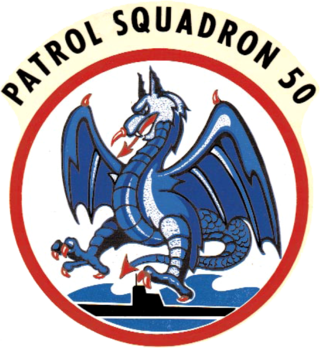
VP-50 was a long-lived Patrol Squadron of the U.S. Navy, having held that designation for 39 years from 1953 to 1992. Its nickname was the Blue Dragons. Originally established as VP-917 on 18 July 1946, redesignated Medium Patrol Squadron (Landplane) VP-ML-67 on 15 November 1946, redesignated VP-892 in February 1950, redesignated VP-50 on 4 February 1953 and disestablished on 30 June 1992.
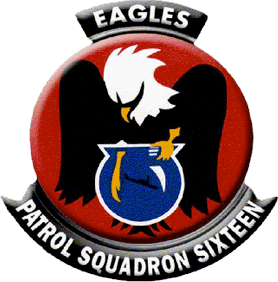
VP-16, nicknamed the War Eagles, is an active Patrol Squadron of the U.S. Navy. It has been based at NAS Jacksonville, Florida since its founding in 1946. The squadron's mission is to operate Maritime patrol aircraft to the fleet in support of national interests. The squadron's radio callsign is "Talon," and their tailcode is "LF." Originally established as Reserve Patrol Squadron 906 (VP-906) in May 1946, it was redesignated Medium Seaplane Squadron 56 (VP-ML-56) on 15 November 1946, redesignated Patrol Squadron 741 (VP-741) in February 1950 and redesignated Patrol Squadron 16 (VP-16) on 4 February 1953. It is the third squadron to be designated VP-16; the first VP-16 was redesignated VP-41 on 1 July 1939 and the second VP-16 was redesignated VPB-16 on 1 October 1944.

796 Naval Air Squadron was a Naval Air Squadron of the Royal Navy's Fleet Air Arm which last disbanded at RNAS Culdrose in October 1958. 796 Naval Air Squadron formed as the Eastern Fleet Torpedo Bomber Reconnaissance Pool, at RN Air Section Port Reitz, in Mombasa, in July 1942, it provided a detachment embarked in HMS Illustrious in August to support the invasion of Madagascar. This Flight also disembarked to Majunga in September to join 207 Group of the Royal Air Force and later rejoined the squadron at RNAS Tanga, in November and added operational training unit to its roles until disbanding in April 1944. It reformed in November 1947 at HMS Vulture, RNAS St Merryn, as the Aircrewman Training School, for conversion of T.A.G.'s to aircrewman standard. Its task changed to Observer School Part II in January 1950. The squadron moved to HMS Seahawk, RNAS Culdrose, in November 1953 and in 1957 took on the task of the disbanded 765 Naval Air Squadron.

Unmanned Patrol Squadron ONE NINE (VUP-19) is an unmanned patrol squadron of the United States Navy, nicknamed the "Big Red" and established on 1 October 2013.

VP-21 was a Patrol Squadron of the U.S. Navy. The squadron was established as Established as Bombing Squadron 111 (VB-111) on 30 July 1943, redesignated Patrol Bombing Squadron 111 (VPB-111) on 1 October 1944, redesignated Patrol Squadron 111 (VP-111) on 15 May 1946, redesignated Heavy Patrol Squadron (Landplane) 11 (VP-HL-11) on 15 November 1946, redesignated Patrol Squadron 21 (VP-21) on 1 September 1948 and disestablished on 21 November 1969. It was the fifth squadron to be designated VP-21, the first VP-21 was redesignated VP-45 on 1 July 1939, the second VP-21 was redesignated VP-1 on 30 July 1940, the third VP-21 was disestablished on 18 April 1942 and the fourth VP-21 was redesignated VPB-21 on 1 October 1944.
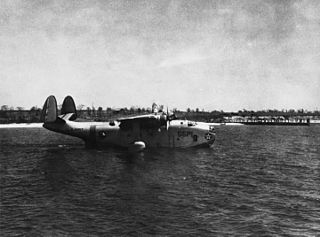
VP-40 was a Patrol Squadron of the U.S. Navy. The squadron was established as Patrol Squadron 55 (VP-55) on 1 August 1940, redesignated Patrol Squadron 74 (VP-74) on 1 July 1941, redesignated Patrol Bombing Squadron 74 (VPB-74) on 1 October 1944, redesignated Patrol Squadron 74 (VP-74) on 15 May 1946, redesignated Medium Patrol Squadron (Seaplane) 10 (VP-MS-10) on 15 November 1946, redesignated Patrol Squadron 40 (VP-40) on 1 September 1948 and disestablished on 25 January 1950.

VP-42 was a Patrol Squadron of the U.S. Navy. The squadron was established as Patrol Squadron 22 (VP-22) on 7 April 1944, redesignated Patrol Bombing Squadron 22 (VPB-22) on 1 October 1944, redesignated Patrol Squadron 22 (VP-22) on 15 May 1946, redesignated Medium Patrol Squadron (Seaplane) 2 (VP-MS-2) on 15 November 1946, redesignated Patrol Squadron 42 (VP-42) on 1 September 1948 and disestablished on 26 September 1969.

VP-40 is a Patrol Squadron of the U.S. Navy. The squadron was established on 20 January 1951. It is the second squadron to be designated VP-40, the first VP-40 was disestablished on 25 January 1950.




















